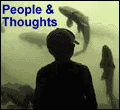forum
library
tutorial
contact

Fish Scientists Set Goals for 'Natural Spawners'
by Dan HansenThe Spokesman Review, April 11, 2002
|
the film forum library tutorial contact |

|
Fish Scientists Set Goals for 'Natural Spawners'by Dan HansenThe Spokesman Review, April 11, 2002 |
Release of numbers sparks debate on whether delisting possible
Nearly two years after unveiling its fish-saving plan for the Columbia River and its tributaries, the government is ready to answer the question biologists frequently hear:
How many salmon and steelhead are enough?
The answer: a lot more than we've got now.
The National Marine Fisheries Service this week released preliminary numbers for a slew of individual rivers and streams. Biologists would like to see 3,750 naturally spawning chinook in the Wenatchee River, for instance, and 400 steelhead in southeastern Washington's Asotin Creek. They'd like to see 1,500 sockeye spawning in Idaho's Stanley Basin.
Hitting those numbers at least four times in eight consecutive years would be just one factor used to determine whether a particular species from a particular area is safe from extinction, said Elizabeth Gaar, NMFS's Northwest salmon recovery coordinator.
Eight years represents two generations of salmon.
Long-term annual productivity is another factor that will be used to determine whether a run of fish is ready to come off the endangered species list. Others are genetic diversity and geographic distribution within a watershed.
But it's the cold, hard numbers that people from the Methow Valley to the Salmon River basin have been waiting to see.
"Before this, we've been kind of operating in the dark," said Bob Bugert, the governor's Eastern Washington salmon recovery coordinator. "This gives a sense ... of how we can start coming up with recovery plans" for individual rivers.
The goals also give Northwesterners a whole new topic for argument. Although few people had seen the numbers Wednesday, "I've already heard a lot of complaints from groups that say they're too low or too high," Bugert said.
Under natural conditions, salmon and steelhead are born in creeks, rivers and mountain lakes, then migrate to the Pacific. A handful successfully make the reverse trip as adults, to spawn in the streams of their birth.
It's the adult fish returning from the ocean on which NMFS is basing its goals.
The numbers are for "natural spawners," meaning fish that were born in the wild and spawn in the wild. That rules out hatchery-reared fish, which comprise about 90 percent of the salmon and steelhead that enter the mouth of the Columbia.
"If they want all-wild fish, there's not too much hope of getting those numbers," said Dick Ewing, a Methow Valley resident who's active on salmon-recovery issues.
Although NMFS is reviewing exactly what role hatcheries should play in fish recovery, the agency interprets the Endangered Species Act to conserve "naturally reproducing and self-sustaining species in their natural ecosystems."
Last year was the best since the 1930s for migrating salmon. Scientists say that's due largely to ideal conditions when young salmon were heading downstream and great conditions once they got to the ocean.
But counting wild fish only, most streams still wouldn't have made the goals set by NMFS. Some examples:
NMFS's goal is 2,000 chinook for the Methow and 3,750 for the Wenatchee.
The NMFS goal is 426 chinook.
NMFS's goal is 1,000 naturally spawning sockeye in any one of the lakes and 500 in another.
The agency is not yet ready to release any numbers for streams that flow into Puget Sound, the lower Columbia or directly into the Pacific. That should happen later this year.
learn more on topics covered in the film
see the video
read the script
learn the songs
discussion forum
